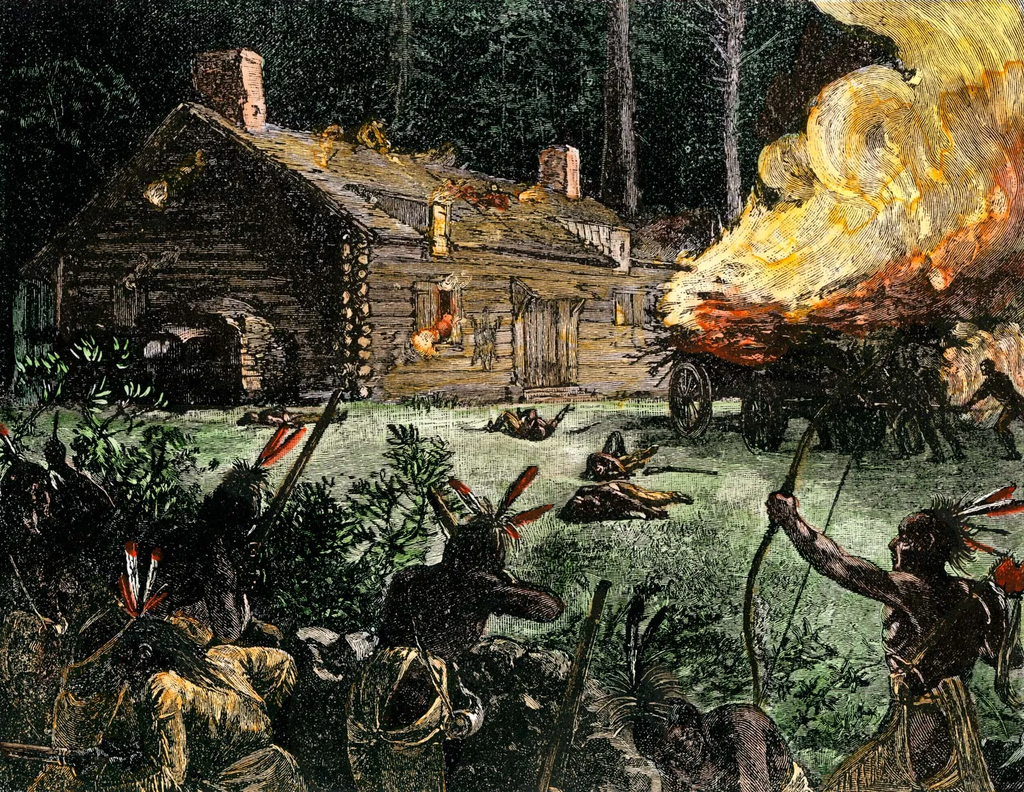Created by Madison Yurich on Thu, 04/25/2024 - 21:30
Description:
This hand-colored woodcut of a 19th century illustration depicts a group of Native Americans attacking a white settlement during King Philip’s War (“King Philip’s War” [Wikipedia]). This war was fought between Native Americans and English settlers from 1675-1676 in New England (“King Philip’s War” [Encyclopædia Britannica]). King Philip’s real name was Metacom, and he was the leader of both the Wampanoag and the Narraganset tribes. During this time of the conflict, the Native Americans and the colonists had been disputing land claims and had been facing disagreements regarding the colonists’ imposition of Christianity on the Native Americans. Finally, in June of 1675, three of King Philip’s warriors were tried and convicted of murdering a white colonist, who served as an interpreter for both of these groups of people. After this accusation and conviction, King Philip and his warriors began many series of attacks on the colonists’ settlements ranging across modern-day Rhode Island, Connecticut, and Massachusetts. By September of the following year, both sides had seen considerable damage and had faced many losses in terms of warriors, civilians, and property (“King Philip’s War” [Encyclopædia Britannica]). But in the end, the colonists had killed thousands of Native Americans and had sold many into slavery.
Slavery was a strong fear that motivated many Native Americans in the fight against the colonists. Many Native Americans warriors feared that their families would be enslaved if they did not fight to defeat the colonists, and for that reason, many Native American men banded together to fight under King Philip (Fisher 93). In a speech given by King Philip to his warriors before a raid he said, “Brothers, you see these little ones, our wives and children, who are looking to us for food and raiment; and you now see the foe before you, that they have grown insolent and bold; that all our ancient customs are disregarded; the treaties made by our fathers and us are broken, and all of us insulted…” (Apess 27) to motivate his men to fight for a cause that was deeper than themselves, a cause that involved the safety and health of their families. He also echoed this fear of enslavement and used it to further motivate his men in battle by saying, “Brothers, these people from the unknown world will cut down our groves, spoil our hunting and planting grounds, and drive us and our children from the graves of our fathers, and our women and children will be enslaved” (Apess 28). Overall, it is evident that the conflict between the Native Americans and the colonists during this time ended in severe destruction of the Native American people and their way of life. Despite King Philip’s efforts, the war resulted in the death and enslavement of thousands of individuals and only made life harder for Native Americans who were trying to practice their own religion and take part in their own cultural practices.
Works Cited
Apess, William. Eulogy on King Philip, as Pronounced at the Odeon in Federal Street, Boston. L.A. Dexter, 1985.
Fisher, Linford D. “‘Why Shall Wee Have Peace to Bee Made Slaves’: Indian Surrenderers during and after King Philip’s War.” Ethnohistory, vol. 64, no. 1, Jan. 2017, pp. 91–114. EBSCOhost, https://doi.org/10.1215/00141801-3688391.
“King Philip’s War.” Encyclopædia Britannica, Encyclopædia Britannica, inc., 5 Apr. 2024, www.britannica.com/event/King-Philips-War.
“King Philip’s War.” Wikipedia, Wikimedia Foundation, 13 Apr. 2024, en.wikipedia.org/wiki/King_Philip%27s_War#/media/File:KingPhilipsWarAttack.webp.


